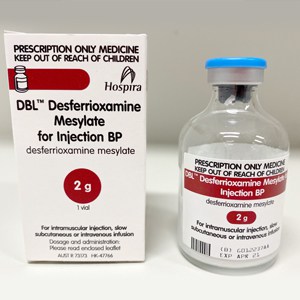Presentation
- 500mg vial
- 2000mg vial
Role
- Management of severe iron toxicity evidenced by GI haemorrhage, severe hypotension, coma, or metabolic acidosis and serum iron concentration >60 micromol/L (or unavailable).
- Management of patients with iron poisoning and an iron concentration >90 micromol/L at 6h post ingestion.

All cases should be discussed with a clinical toxicologist through the local toxicology service or Poisons Information Centre 13 11 26.
Dose
Give 15mg/kg/hr as an IV infusion until serum iron concentration falls below 60 micromol/L. Therapy is typically needed for 6 hours. The dose should be reduced by 50% in renal impairment (eGFR < 50mL/min).
Stocking recommendations
| Tertiary centre | Regional centre | Rural centre | Remote centre |
|---|---|---|---|
|
20 x 500mg vials or 5 x 2g vials |
20 x 500mg vials or 5 x 2g vials |
0 – 10 x 500mg vials or 0 – 2 x 2g vials | 0 vials |
Rationale
Iron chelation is uncommonly required. 10g supply will provide a full treatment course for a 100kg person. For rural centres, 4-5g will be sufficient to initiate therapy in anticipation of retrieval to a regional or tertiary centre. However, given this is an uncommon poisoning stocking in a rural centre is not essential.
Precautions
- Infusion-related hypotension is common, ensure adequate hydration before commencing infusion.
- Urine will often change to a vin rose colour following desferrioxamine.
Disclaimer
Fact sheet developed by Queensland Poisons Information Centre.
This fact sheet is about the use of these antidotes in Australia, and may not apply to other countries. Children’s Health Queensland Hospital and Health Service cannot be held responsible for the accuracy of information, omissions of information, or any actions that may be taken as a consequence of reading this fact sheet.